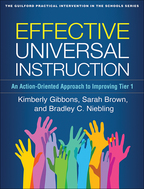Effective Universal Instruction
An Action-Oriented Approach to Improving Tier 1
Kimberly Gibbons, Sarah Brown, and Bradley C. Niebling
A Paperback Originale-bookprint + e-book
A Paperback Original
orderDecember 4, 2018
ISBN 9781462536832
Price: $38.00 220 Pages
Size: 8" x 10½"
This accessible volume helps school leadership teams accomplish the crucial yet often overlooked task of improving universal instruction—Tier 1 within a multi-tiered system of support (MTSS). Strong universal instruction reduces the numbers of PreK–12 students who may need additional services and supports. Providing clear action steps and encouraging guidance, the expert authors present a roadmap for evaluating the effectiveness of Tier 1, identifying barriers to successful implementation, and making and sustaining instructional improvements. In a large-size format for easy photocopying, the book includes 27 reproducible checklists, worksheets, and forms. Purchasers get access to a Web page where they can download and print the reproducible materials.
This title is part of The Guilford Practical Intervention in the Schools Series, edited by Sandra M. Chafouleas.
“Providing a contemporary view of universal instruction, this book should be in the hands of all district, school, grade, and departmental teams. Each chapter engages readers in thoughtful reflection about core instructional features that improve student outcomes. Gibbons, Brown, and Niebling are experienced experts who explain the issues, decisions, and evaluation processes that school teams need to master for effective continuous improvement. The authors' approach is strengths based and systemic, and the book's tools and exemplars make this deep dive into universal instruction both inviting and accessible.”
—Dawn Miller, PhD, SWIFT Education Center (Schoolwide Integrated Framework for Transformation), University of Kansas
“Today's educators are expected to help every single student grow academically, and it all starts with core instruction. Yet many do not understand the importance of this essential element of teaching and learning. Finally, we have a forthright resource that clearly explains a process for improving universal instruction. A 'must read' for professional learning communities across the country—I can only imagine the power of instruction once school leaders and teachers collectively get hold of this book!”
—Julia Ann Espe, EdD, Superintendent, Princeton Public Schools, Minnesota
“A school cannot begin to support all of its students' needs without first addressing the effectiveness of universal instruction. This book walks school leadership teams through a process for doing just that. The discussion questions at the end of each chapter serve as helpful prompts for meaningful reflection and, more important, action. I can't wait to engage in a book study with my team using this as a guide!”
—Jamie Nord, EdS, Executive Director, St. Croix River Education District, Rush City, Minnesota
“At a time when schools have found themselves trying to intervene their way to improvement, this book gets to the heart of what principals all too often neglect—implementation fidelity of the core curriculum. Gibbons, Brown, and Niebling not only remind us of the importance of Tier 1 instruction, but also provide practical ways that school leadership teams can assess their school's current state of effectiveness, remove barriers to improving instruction, and, most important, evaluate their own efforts. This is a book that principals and other school leaders need to have and use.”
—Katie Pekel, EdD, Principal in Residence, College of Education and Human Development, University of Minnesota
Table of Contents
1. Introduction
2. Learning Targets
3. Universal Tier Assessments
4. Determining the Effectiveness of Universal Instruction
5. Identifying Barriers to Effective Universal Tier Implementation
6. Action Planning to Address Barriers to Universal Tier Instruction
7. Implementing Universal Tier Improvements
8. Evaluating Core Improvement Efforts
9. Continuing the Journey
About the Authors
Kimberly Gibbons, PhD, is Associate Director of the Center for Applied Research and Educational Improvement at the University of Minnesota. Prior to that, she was Executive Director of the St. Croix River Education District in Minnesota. During this tenure, she was named Outstanding Administrator of the Year by the Minnesota Administrators of Special Education (MASE); she is also a past president of MASE. Dr. Gibbons provides national consultation and has numerous publications on response to intervention and data-based decision making.Sarah Brown, PhD, is Senior Director of Learning and Development at FastBridge Learning in Minnesota. Her work focuses on implementing multi-tiered systems of support (MTSS) at multiple levels of the education system and improving systems to support high achievement for every student. Previously, Dr. Brown has had several administrative roles, including serving as a Bureau Chief at the Iowa Department of Education, where she led statewide implementation of MTSS, and as a Unique Learners’ Manager at the St. Croix River Education District in Minnesota. She also worked at the Center for Applied Research and Educational Improvement at the University of Minnesota.
Bradley C. Niebling, PhD, is Bureau Chief for Learner Strategies and Supports at the Iowa Department of Education, where he leads statewide implementation of multi-tiered systems of support (MTSS), supports Iowa’s statewide implementation of the Iowa Core State Standards, and works with schools to improve Tier 1 practices within MTSS. Prior to that, Dr. Niebling worked at the university, school, and intermediate service agency levels as a school psychologist, trainer, and researcher. He has published multiple journal articles and book chapters on standards-based practices, curriculum alignment, and response to intervention/MTSS.
